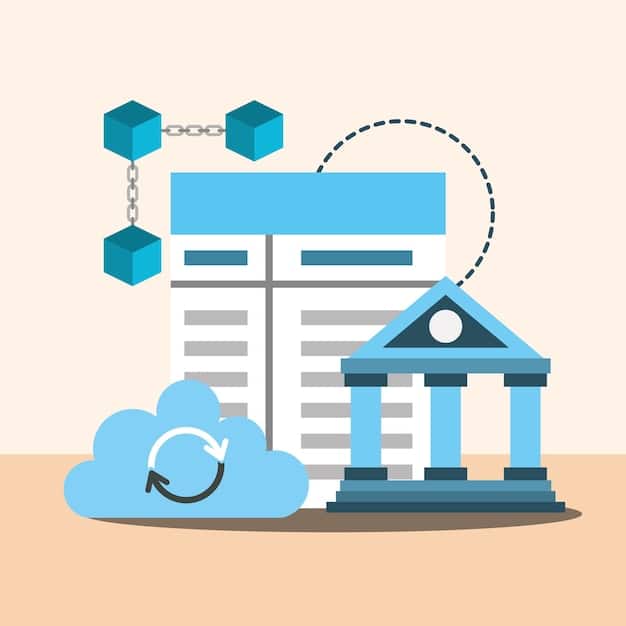Blockchain for Good: Boosting Charity Transparency in the US

Blockchain technology offers a novel approach to enhance transparency and accountability in charitable donations within the US, ensuring funds are used efficiently and effectively, building greater trust with donors.
The intersection of blockchain and charity: increasing transparency and accountability in donations in the US is no longer just a futuristic concept. It’s a tangible solution to some of the most pressing issues facing the non-profit sector today. But how does it work, and what makes it so revolutionary?
Understanding the Basics of Blockchain Technology
Before diving into its applications in charity, it’s essential to grasp the core principles of blockchain technology. At its heart, blockchain is a decentralized, immutable ledger that records transactions across many computers. This distributed nature makes it inherently transparent and secure.
Essentially, every transaction is grouped into “blocks” which are then chained together chronologically. Each block contains a cryptographic hash of the previous block, creating an unbroken chain. Any attempt to alter a previous block would require changing all subsequent blocks, which is computationally infeasible, ensuring data integrity.
Key Features of Blockchain
Several key features make blockchain particularly attractive for use in charitable organizations.
- Transparency: Every transaction is recorded on the blockchain and can be viewed by anyone with access.
- Security: The cryptographic nature of blockchain ensures that data is tamper-proof.
- Efficiency: Blockchain can automate processes, reducing administrative overhead and transaction costs.
- Immutability: Once a transaction is recorded, it cannot be altered or deleted.
The combined effects of these features mean that blockchain can bring unprecedented levels of trust and efficiency to charitable giving, particularly in the United States where donor confidence is paramount.
The Current State of Charity in the US
Understanding the potential of blockchain in the charitable sector requires an appreciation of the landscape of charity in the US. Americans are generally very giving people, yet trust in charities has seen fluctuations over recent years. Blockchain can help to rebuild and reinforce the trust that is crucial for maintaining this generosity.
Currently, charities face challenges regarding transparency, efficiency, and accountability. Donors often question how their money is used, and administrative overhead can eat into the funds meant for actual charitable activities. Blockchain offers a viable solution to enhance these aspects.

Challenges in US Charities
US-based charities encounter several key challenges including:
- Lack of Transparency: Donors often find it difficult to trace how their donations are used.
- High Administrative Costs: Significant portions of donations are often consumed by administrative overhead.
- Donor Mistrust: Doubts about the efficiency and honesty of charities can deter potential donors.
- Inefficient Processes: Traditional methods of fundraising and fund management can be slow and costly.
By addressing these challenges, blockchain technology has the potential to revolutionize how charities operate, fostering greater accountability and encouraging more donors to contribute.
How Blockchain Enhances Transparency in Donations
One of the biggest promises of blockchain in the charitable sector is the ability to enhance transparency. Every donation made through a blockchain-based system can be tracked in real-time, providing donors with unprecedented visibility into how their contributions are being used.
With blockchain, donors can see exactly where their money goes, from the initial donation to the final disbursement. This can significantly increase trust and encourage repeat donations. The technology enables a direct connection between the donor’s intentions and the charity’s actions.
Real-Time Tracking
Real-time tracking is a game-changer for charity. Donors can follow their donations:
- From the moment the donation is made.
- Through the various stages of fund allocation.
- To the ultimate beneficiary or project.
This level of transparency eliminates much of the ambiguity that can undermine donor trust.
Increasing Accountability with Blockchain
Beyond transparency, blockchain can also increase accountability in charitable organizations. By creating an immutable record of all transactions, blockchain makes it much harder for funds to be misused or misappropriated. This feature is particularly appealing in an environment where public scrutiny is high.
Smart contracts, which are self-executing agreements written into the blockchain, can also play a significant role. They can automate the disbursement of funds based on predefined conditions, ensuring that donations are used specifically for their intended purpose.

The Role of Smart Contracts
Smart contracts can ensure:
- Funds are used for their intended purpose.
- Disbursements are made automatically when certain conditions are met.
- Greater efficiency and reduced administrative overhead.
This reduces the need for intermediaries and manual oversight, increasing trust and efficiency.
Examples of Blockchain Use in US Charities
Though still in its early stages, several US charities have successfully implemented blockchain technology to improve their operations. These examples provide a glimpse into the potential of this technology to transform the charitable sector.
For instance, some organizations are using blockchain to create transparent donation platforms where donors can track their contributions in real-time. Others are using smart contracts to automate the disbursement of funds and ensure they are used for specific projects.
Case Studies
Some emerging examples are:
- BitGive Foundation: One of the first non-profits to leverage Bitcoin and blockchain technology for charitable giving.
- Alice.si: A platform allowing donors to see exactly how their donations are spent, ensuring accountability.
- Endaoment: Building community foundation infrastructure on the blockchain for charitable giving.
These uses highlight the potential of blockchain to transform how charities operate.
Overcoming Challenges and Future Opportunities
Despite the potential benefits, there are still challenges to overcome before blockchain can be widely adopted in the US charitable sector. These include regulatory uncertainty, technological complexity, and a lack of awareness among donors and charities alike.
However, as blockchain technology matures and becomes more accessible, these challenges are likely to diminish. In the future, we can expect to see more charities adopting blockchain-based systems to enhance transparency, accountability, and efficiency.
Future Outlook
Opportunities for blockchain in charity include:
- Wider Adoption: As more charities embrace blockchain, its benefits will become more widely recognized.
- Technological Advancements: Ongoing developments in blockchain technology will make it easier to implement and use.
- Increased Donor Trust: Enhanced transparency and accountability will lead to greater donor confidence and increased giving.
| Key Point | Brief Description |
|---|---|
| 🔑 Enhanced Transparency | Blockchain enables real-time tracking of donations, fostering greater trust. |
| 🛡️ Increased Accountability | Immutable records and smart contracts ensure funds are used as intended. |
| 🚀 Greater Efficiency | Automation reduces administrative costs and speeds up processes. |
| 🌐 Global Reach | Blockchain facilitates cross-border donations with reduced fees. |
Frequently Asked Questions
▼
Blockchain is a decentralized, immutable ledger that records transactions across a network of computers, ensuring transparency and security. Every transaction is grouped into “blocks” which are chained together.
▼
Blockchain allows real-time tracking of donations, from the moment they’re made to when they reach their intended use. This provides donors with unprecedented visibility and builds trust in the charity.
▼
Smart contracts are self-executing agreements written into the blockchain. They automate fund disbursement based on predefined conditions, ensuring donations are used as intended by the donor.
▼
Challenges include regulatory uncertainty, technological complexity, and a lack of awareness among charities and donors. Overcoming these challenges will pave the way for broader adoption.
▼
Yes, blockchain can automate various processes, such as fund disbursement, reducing the need for manual oversight and intermediaries. This can significantly lower administrative costs and free up funds.
Conclusion
In conclusion, the adoption of blockchain technology in US charities offers a promising path towards greater transparency, accountability, and efficiency. While challenges remain, the potential benefits are significant, ultimately increasing donor trust and enabling charities to better fulfill their missions.





